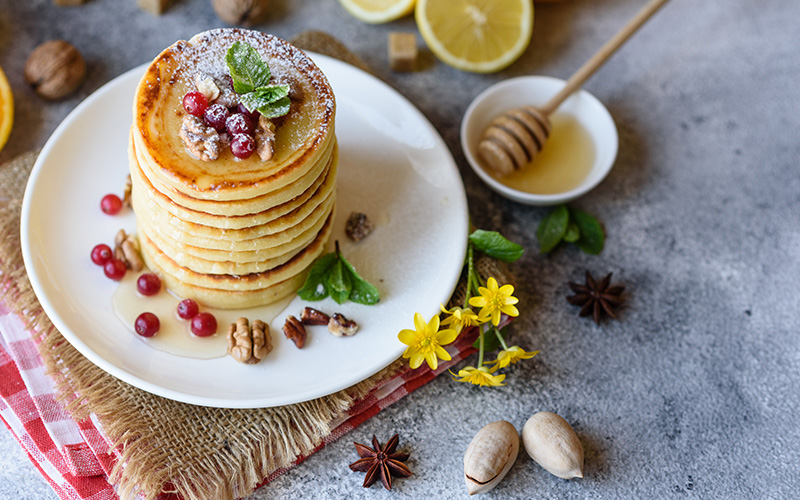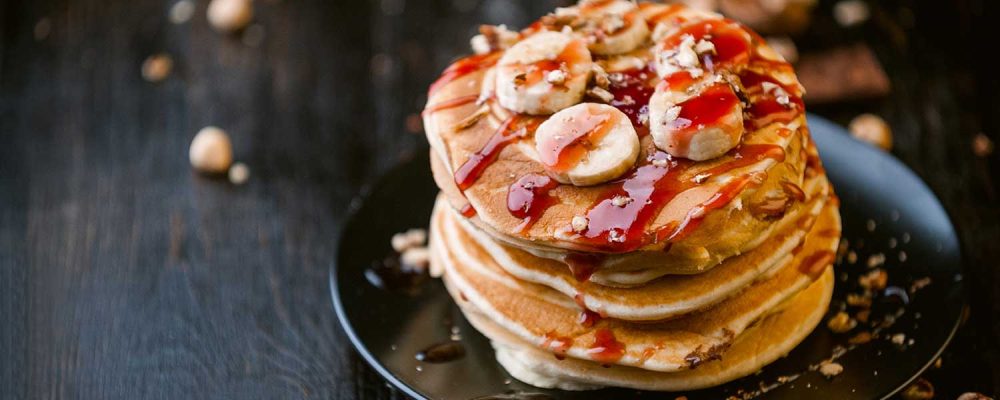This gluten-free pancake recipe showcases a thoughtful, considerate, and well-balanced approach to enjoying pancakes once again. It ensures a delectable, rich, and fulfilling breakfast for those with gluten sensitivities.
Gluten sensitivity has caused many people to be worried about their diet these days. In fact, it has made it almost impossible to savor pancakes for those with gluten allergies.
Moreover, the versatility of gluten-free all-purpose flour showcases how classic recipes can also cater to diverse dietary needs.
Getting Started
Achieving perfect gluten-free pancakes requires precision and the right utensils. You can start by separating dry and wet ingredients into two bowls.
To maintain fluffiness, gently blend with a whisk, avoiding over mixing. Additionally, accurate measurements, especially for liquids like buttermilk, are crucial with the proper use of measuring cups and spoons.
Use a griddle or nonstick pan for even cooking, and use a wide, flat spatula for easy flipping. Allow the pancakes to cool on a rack after cooking, and use cooking spray or butter to prevent sticking. In addition, utilize a timer to prevent over mixing and a flat-topped turn for gentle flipping. For a smoother batter, an electric mixer can be used.
Primary Ingredients for the Gluten-Free Pancake Recipe
The basic ingredients listed in this gluten-free pancake recipe each play a crucial role in achieving a delightful and satisfying outcome especially when diet matters.[1]
- 1 Cup Gluten-Free Flour: While traditional pancakes rely on gluten for texture, this gluten-free alternative ensures a similar structure without compromising dietary preferences.
- 1 Tablespoon Sugar: The tablespoon of sugar serves not only to sweeten the pancakes but also to enhance the overall flavor.
- 1 Teaspoon Baking Powder and ½ Teaspoon Baking Soda: A teaspoon of baking powder and a half teaspoon of baking soda act as leavening agents, working synergistically to give the pancakes a light and fluffy texture.
- Pinch of Salt: Salt also plays a role in regulating the chemical reactions between the leavening agents.
- 1 Cup of Buttermilk: Buttermilk, or a dairy-free option for people who have lactose intolerance, introduces a creamy texture and tangy taste that elevates the pancake’s overall richness.[2]
- 1 Large Egg: The egg not only contributes to the structure, it also adds moisture, ensuring that the pancakes are not dry.
- 2 Tablespoons Melted Butter: Butter enhances the mouthfeel and flavor of the pancakes.
- 1 Teaspoon Vanilla Extract: Vanilla extract introduces a pleasing aromatic note that complements the other ingredients
Step-by-Step Instructions

For making a perfect gluten-free pancake recipe, you’ll need to follow these step-by-step instructions:
- Mix Dry Ingredients: In a bowl, whisk together the gluten-free flour, sugar, baking powder, baking soda, and salt.
- Combine Wet Ingredients: In another bowl, whisk together the buttermilk, egg, melted butter, and vanilla extract.
- Combine Mixtures: Mix the wet ingredients into the dry ingredients then stir until just combined. Be careful not to overmix; a few lumps are okay.
- Preheat Cooking Surface: Preheat a nonstick pan or griddle over medium heat. If needed, lightly grease the surface with cooking spray or butter.
- Pour Batter: Pour portions of the batter onto the pan or griddle for each pancake, spacing them slightly apart.
- Cook Until Bubbles Form: Cook until bubbles form on the surface of the pancakes and the edges look set. This usually takes 2-3 minutes.
- Flip and Cook: You must flip the pancakes with a wide spatula and cook for an additional 1-2 minutes or until the other side is golden brown.
- Serve: For serving, transfer the pancakes to a plate and serve warm with your favorite toppings, such as fresh fruit chunks, maple syrup, or whipped cream.
Pairing and Serving Suggestions for Gluten-Free Pancakes

Gluten-Free Pancake Recipe Variations
Gluten-free pancakes are a compact, healthy, and tasty meal. Introducing variations to this meal can elevate your taste buds with a unique twist. Below are some options worth trying:
- Scallion Gluten-Free Pancakes: Scallion pancakes include chopped scallions, which add a savory and slightly onion-like taste. They can be enjoyed with various dipping sauces made with soy sauce, vinegar, and sesame oil.
- Apple Cider Pancakes: You can use apple cider and grated apples in the batter, paired with cinnamon
- Chia Seed Pancakes: Add chia seeds to the batter for extra nutritional benefits and a subtle crunch for a taste of autumn.
- Sweet Potato Pancakes: You can also add mashed sweet potatoes and a touch of cinnamon for a nutritious and flavorful option.
- Chocolate Chip Delight: If you are a chocolate lover, you can sprinkle gluten-free chocolate chips into the batter for a decadent and indulgent pancake experience.
- Gingerbread Pancakes: When considering a new variation, you can add ginger, cinnamon, and molasses to the batter for a warm and comforting breakfast.
- Coconut Pineapple Pancakes: Mixing shredded coconut and diced pineapple into the batter for a tropical-inspired breakfast is also a great idea.
- Trail Mix Pancakes: You can mix in a combination of dried fruits, nuts, and seeds for a hearty and energizing breakfast.
Serving Suggestions
- Caprese Pancakes: Layering sliced tomatoes, fresh mozzarella, and basil on your pancakes, and drizzling with balsamic glaze offers a refreshing option.
- Almond Butter and Sliced Strawberries: Spread almond butter on your pancakes and garnish with fresh strawberry slices for a nutty, fruity, delightful experience.
- Mixed Fruit Salad: You can create a refreshing topping by piling a colorful assortment of diced mixed fruits, such as kiwi, pineapple, and melon, on your pancakes.
Pairing Suggestions
- Mushroom and Spinach Saute: Saute mushrooms and spinach in garlic and olive oil, then place them over your pancakes for a savory and nutritious option.
- Strawberries and Chocolate: You can create a dessert-like delight by topping your pancakes with sliced strawberries and a drizzle of melted chocolate.
- Lemon Curd: You can add lemon curd as a dip for a burst of citrusy sweetness.
- Honey Mustard Chicken: You can also combine the sweet and tangy flavors of honey mustard chicken with your gluten-free pancakes for a delightful meal.
- Brie and Cranberry Compote: Including the richness of Brie cheese paired with a homemade cranberry compote can also give a different vibe to regular gluten-free pancakes.
Carb Calculation and Nutritional Info for Gluten-Free Pancakes
Based on the expected values for each ingredient, here are how many calories are in a serving of gluten-free pancakes:
Total Net Carb Calculation
1 Cup Gluten-free All-Purpose Flour
Carbohydrates – 96g
Protein – 4g
Fat – 2g
Fiber – 4g
1 Tablespoon Sugar
Carbohydrates – 12g
Protein – 0g
Fat – 0g
1 Teaspoon Baking Powder
Carbohydrates – 1.5g
Protein – 0g
Fat – 0g
1/2 Teaspoon Baking Soda
Carbohydrates – 0g
Protein – 0g
Fat – 0g
1/4 Teaspoon Salt
Sodium – 500mg
1 Cup Buttermilk
Carbohydrates – 12g
Protein – 8g
Fat – 8g
Calcium – 300mg
1 Large Egg
Carbohydrates – 1.5g
Protein – 6.5g
Fat – 5g
2 Tablespoons Melted Butter
Carbohydrates – 0g
Protein – 0.2g
Fat – 23g
1 Teaspoon Vanilla Extract
Total Estimated Nutritional Value for One Serving of Gluten-Free Pancakes:
Carbohydrates – 123g
Protein – 19.7g
Fat – 38.2g
Fiber – 4g
Sodium – 500mg
Storing and Reheating Gluten-Free Pancakes
If precautions are maintained while storing and reheating gluten-free pancakes, then waste can be eliminated. Additionally, following these guidelines should help you preserve the texture and flavor of your pancakes when storing and reheating them
Guidelines for Storing Gluten-Free Pancakes
- Cooling Process: Allow the gluten-free pancakes to cool completely before storing. This helps prevent condensation inside the storage container, which can lead to sogginess.
- Separating Layers: Place sheets of parchment paper or wax paper between each pancake to prevent them from sticking together. This makes it easier to separate individual pancakes when reheating.
- Airtight Container or Freezer Bag: Store the pancakes in an airtight container or a sealed freezer bag to minimize exposure to air, which can lead to freezer burn.
- Labeling: If you’re freezing the pancakes, consider labeling the container with the date to keep track of freshness.
- Refrigeration or Freezing: If you plan to consume the pancakes within a few days, store them in the refrigerator. For longer storage, place them in the freezer.
Guidelines for Reheating Gluten-free Pancakes
- Microwave: Microwave on medium power for 20-30 seconds at a time until pancakes are heated through.
- Oven: You can preheat your oven to around 350°F (175°C). Wrap the pancakes in aluminum foil and reheat for about 10-15 minutes or until warmed through.
- Toaster: you can reheat individual pancakes in a toaster for a quick and convenient option. Keep an eye on them to prevent burning.
- Stovetop: You might also use a skillet or griddle to reheat pancakes over low to medium heat. Cover them to trap steam and retain moisture.
- Steamer: Use a steamer basket to gently reheat pancakes. This method helps maintain their soft texture.
In Closing
Relish the magic of gluten-free pancake creation with recipes that are good for everyone. Indeed, these gluten-free pancake recipes offer a thoughtful mix of flavors — from traditional favorites to new takes on old favorites.
Lastly, these pancakes promise a tasty, flavorful, and filling breakfast choice. Furthermore, each version of the recipe fits in well with the principles of gluten-free goodness. Whether you prefer the savory appeal of pancakes with scallions or the comforting hint of sweetness of pancakes with sweet potatoes, both options provide delicious alternatives.
References
[1] Saturni, L., Ferretti, G., & Bacchetti, T. (2010). The gluten-free diet: safety and nutritional quality. Nutrients, 2(1), 00016-00034. https://doi.org/10.3390/nu2010016
[2] Li, A., Zheng, J., Han, X., Yang, S., Cheng, S., Zhao, J., … & Lu, Y. (2023). Advances in Low-Lactose/Lactose-Free Dairy Products and Their Production. Foods, 12(13), 2553. https://doi.org/10.3390/foods12132553
RV Team
* Reviewology is in partnership or collaborates with top brands highlighted on this site, including those occupying the top ranking positions.
Additionally, we earn affiliate commissions from products showcased on this website when you make a purchase through the provided links on Amazon or the company website directly.
We appreciate your support using our links to purchase your favorite brands or newly discovered brands.
Latest updates
I Thought I’d Always Feel Tired, Fat, and Forgotten—Until This
310 Greens vs AG1
The Truth About 310 Greens: A No-Nonsense Review of This Popular Supplement
Popular
I Thought I’d Always Feel Tired, Fat, and Forgotten—Until This
310 Greens vs AG1
The Truth About 310 Greens: A No-Nonsense Review of This Popular Supplement
© 2024 Reviewology. All Rights Reserved.
